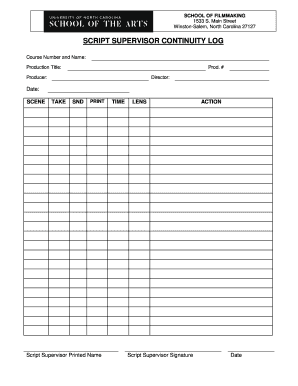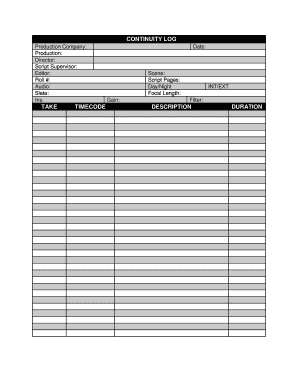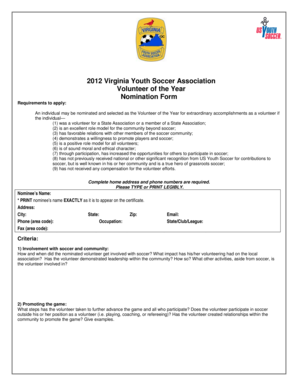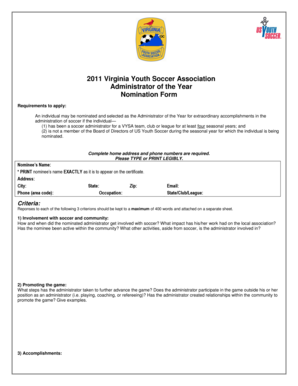
Get the free templates contracts form
Show details
CONTINUITY LOG SHEET
Production titleDateDirectorSceneEditorShoot script SupervisorFilmsourcing accepts no legal responsibility for the use of Film sourcing sample contracts or templates.
We are not affiliated with any brand or entity on this form
Get, Create, Make and Sign

Edit your templates contracts form form online
Type text, complete fillable fields, insert images, highlight or blackout data for discretion, add comments, and more.

Add your legally-binding signature
Draw or type your signature, upload a signature image, or capture it with your digital camera.

Share your form instantly
Email, fax, or share your templates contracts form form via URL. You can also download, print, or export forms to your preferred cloud storage service.
How to edit templates contracts online
Here are the steps you need to follow to get started with our professional PDF editor:
1
Check your account. If you don't have a profile yet, click Start Free Trial and sign up for one.
2
Prepare a file. Use the Add New button. Then upload your file to the system from your device, importing it from internal mail, the cloud, or by adding its URL.
3
Edit sample contracts form. Rearrange and rotate pages, add and edit text, and use additional tools. To save changes and return to your Dashboard, click Done. The Documents tab allows you to merge, divide, lock, or unlock files.
4
Save your file. Select it from your records list. Then, click the right toolbar and select one of the various exporting options: save in numerous formats, download as PDF, email, or cloud.
With pdfFiller, it's always easy to work with documents. Try it out!
How to fill out templates contracts form

How to fill out templates contracts:
01
Start by carefully reviewing the template contract and ensuring that it covers all the necessary clauses and provisions for your specific situation.
02
Enter the relevant information in the contract, such as the names and addresses of the parties involved, the effective date, and any specific terms or conditions.
03
Customize the contract to meet your specific requirements, if needed. Add or remove clauses as necessary to reflect the terms that both parties have agreed upon.
04
Double-check the contract for any errors or inconsistencies. Make sure that all the information is accurate and that there are no grammatical or spelling mistakes.
05
Ensure that both parties fully understand and agree to the contract terms before signing it. If necessary, consult with legal counsel to clarify any questions or concerns.
06
Make copies of the signed contract for all parties involved and keep them in a safe and accessible place for future reference.
Who needs templates contracts:
01
Individuals or businesses involved in various types of agreements, such as employment contracts, lease agreements, or purchase agreements, may benefit from using template contracts.
02
Professionals, such as lawyers, consultants, or freelance writers, who frequently need to draft contracts for their clients, can save time and effort by utilizing templates.
03
Startup founders or small business owners who are just starting out and may not have the resources to hire legal professionals can leverage template contracts as a starting point for their agreements.
Fill clients contracts : Try Risk Free
People Also Ask about templates contracts
How do I draft my own contract?
Can I use a template for a contract?
How do you draft a contract template?
How do you write a contract template?
What is contract template?
Can I create my own contract?
For pdfFiller’s FAQs
Below is a list of the most common customer questions. If you can’t find an answer to your question, please don’t hesitate to reach out to us.
What is templates contracts?
Template contracts refer to pre-written, standardized contract documents that can be customized to fit the specific needs of different parties involved in a business transaction. These templates provide a basic framework for the agreement, outlining the key terms and conditions that are typically included in such contracts. They are commonly used to streamline the contract creation process, saving time and effort for individuals and organizations that frequently engage in similar types of agreements. Template contracts can cover various areas, including employment, real estate, sales, services, and partnerships, among others. However, it is important to note that while template contracts can be a useful starting point, they often need to be carefully reviewed and tailored to accurately reflect the specific details of each transaction. Legal advice is recommended to ensure that the contract effectively protects the interests of all parties involved.
Who is required to file templates contracts?
There is no specific requirement for individuals or entities to file template contracts. Templates contracts are typically used as standardized forms that can be adapted for specific situations and used by individuals or businesses for their own purposes. However, certain industries or regulatory bodies may mandate the filing or registration of specific types of contracts or agreements. For example, real estate contracts may need to be filed with local government authorities, or certain financial contracts may need to be registered with relevant financial regulatory bodies. It is important to consult legal advice or local regulations for specific requirements related to filing or registration of contracts in a particular jurisdiction or industry.
How to fill out templates contracts?
Filling out template contracts can vary depending on the specific template being used, but generally, the following steps can help guide you through the process:
1. Review the contract: Read through the template contract thoroughly to understand its purpose and scope. Make sure that it aligns with your specific needs and requirements.
2. Personalize the details: Modify the contract to include the specific details relevant to your situation. This may involve replacing placeholders (such as [Your Name], [Company Name], [Address], etc.) with your actual information.
3. Customize the terms and conditions: Adapt the terms and conditions section according to your specific arrangement or agreement. Ensure that the language accurately reflects your intent and expectations.
4. Add any additional provisions: If there are any additional clauses or provisions that need to be included to address specific situations or concerns, insert them into the contract. Ensure that they are clear, concise, and legally sound.
5. Seek legal advice (if necessary): If the contract involves complex legal matters or if you are unsure about certain clauses, it may be wise to consult with an attorney to ensure compliance with local laws and regulations.
6. Review and revise: Carefully proofread the entire contract to check for any errors or omissions. Ensure that the language used is clear, consistent, and easily understandable by all parties involved. Make any necessary revisions or amendments.
7. Obtain necessary signatures: Once the contract has been completed, ensure that all relevant parties review it, understand its implications, and sign it. This verifies mutual agreement and consent to the terms and conditions stated within the contract.
Please note that using templates cannot replace professional legal advice, and it is recommended to consult with an attorney to ensure that the contract appropriately addresses your specific needs and local legal requirements.
What is the purpose of templates contracts?
The purpose of template contracts is to provide a standardized format and structure for various types of legal agreements. These templates serve as a starting point or reference point for drafting contracts, saving time and effort in creating agreements from scratch. They include pre-written clauses, terms, and provisions that are commonly used and accepted in specific industries or legal contexts.
Template contracts offer several benefits:
1. Efficiency: Templates streamline the contract drafting process by providing a framework with pre-written and validated language. This helps save time and resources by eliminating the need to start from scratch for each new contract.
2. Consistency: Templates ensure consistency in the language and clauses used across contracts. This can be particularly important for companies that have frequent recurring agreements or contracts with similar terms.
3. Legal Compliance: Template contracts often incorporate legally sound clauses and terms that comply with relevant laws and regulations. This reduces the risk of overlooking important legal requirements or provisions.
4. Risk Mitigation: By using template contracts, parties can minimize the potential for disputes or misunderstandings. Templates typically include clauses that address common issues, such as dispute resolution, warranties, liability limitations, or termination conditions, helping to minimize risks and protect the parties' interests.
5. Best Practices: Templates often include language that reflects industry-specific best practices or commonly accepted standards. This helps ensure that contracts include provisions that are well-regarded and aligned with prevailing norms within a particular industry.
While template contracts provide a useful starting point, it is important to tailor them to the specific needs and circumstances of each agreement. Parties should carefully review and customize the templates to accurately reflect their intentions and the unique aspects of their business transactions. It is recommended to seek legal advice to ensure that the final contract accurately represents the parties' interests and satisfies all legal requirements.
What information must be reported on templates contracts?
The information that must be reported on template contracts can vary depending on the specific type of contract and the jurisdiction in which it is being used. However, some common elements that are typically included in most contracts are:
1. Identification of the parties involved: The full legal names and contact information of all parties entering into the contract.
2. Contract purpose: A clear and concise description of the purpose or objective of the contract.
3. Terms and conditions: The specific rights, responsibilities, and obligations of each party involved in the agreement. This may include payment terms, delivery schedules, performance expectations, warranties, and liability provisions.
4. Duration and termination: The start date and end date (if applicable) of the contract, as well as any provisions for early termination or renewal.
5. Price and payment terms: The total compensation or price agreed, including details of any installments, due dates, and payment methods.
6. Confidentiality and non-disclosure: If applicable, any provisions regarding the protection and confidentiality of sensitive information shared during the course of the contract.
7. Dispute resolution: Procedures for resolving any potential disputes that may arise during the term of the contract. This may include provisions for negotiation, mediation, or arbitration.
8. Governing law and jurisdiction: The specific laws and jurisdiction that will govern the interpretation and enforcement of the contract.
9. Signatures: The contract should allow space for all parties involved to sign and date, indicating their agreement to the terms and conditions outlined in the contract.
It is important to note that this is a general guideline, and the specific requirements for reporting information on a template contract can vary based on the type of contract, location, and applicable laws.
What is the penalty for the late filing of templates contracts?
The penalty for late filing of template contracts can vary depending on the jurisdiction and the specific circumstances. In many cases, there can be financial penalties imposed, which might include late fees or fines. The exact amount of the penalty can vary, and it is typically determined by the governing body or authority responsible for enforcing the filing requirements. Additionally, late filing may also result in other consequences such as loss of certain rights, privileges, or even legal consequences. It is advisable to consult the relevant laws, regulations, or legal counsel in your specific jurisdiction to determine the exact penalties for late filing of template contracts.
How do I modify my templates contracts in Gmail?
sample contracts form and other documents can be changed, filled out, and signed right in your Gmail inbox. You can use pdfFiller's add-on to do this, as well as other things. When you go to Google Workspace, you can find pdfFiller for Gmail. You should use the time you spend dealing with your documents and eSignatures for more important things, like going to the gym or going to the dentist.
Can I create an eSignature for the valid contract in Gmail?
You can easily create your eSignature with pdfFiller and then eSign your rep contract directly from your inbox with the help of pdfFiller’s add-on for Gmail. Please note that you must register for an account in order to save your signatures and signed documents.
Can I edit contract based on an Android device?
With the pdfFiller mobile app for Android, you may make modifications to PDF files such as terms contracts form. Documents may be edited, signed, and sent directly from your mobile device. Install the app and you'll be able to manage your documents from anywhere.
Fill out your templates contracts form online with pdfFiller!
pdfFiller is an end-to-end solution for managing, creating, and editing documents and forms in the cloud. Save time and hassle by preparing your tax forms online.

Valid Contract is not the form you're looking for?Search for another form here.
Keywords relevant to contracts clients form
Related to contract film service
If you believe that this page should be taken down, please follow our DMCA take down process
here
.























